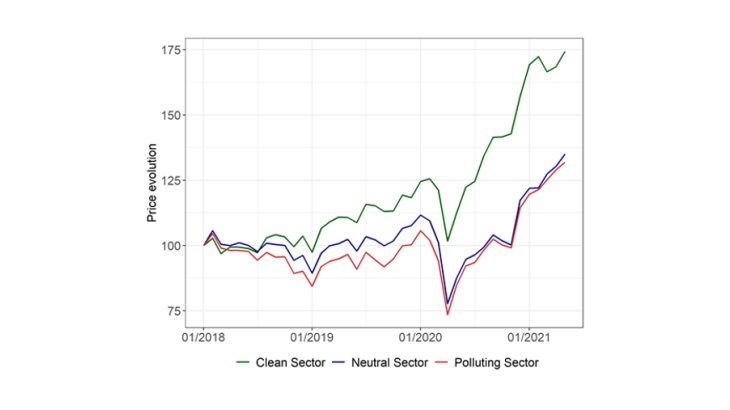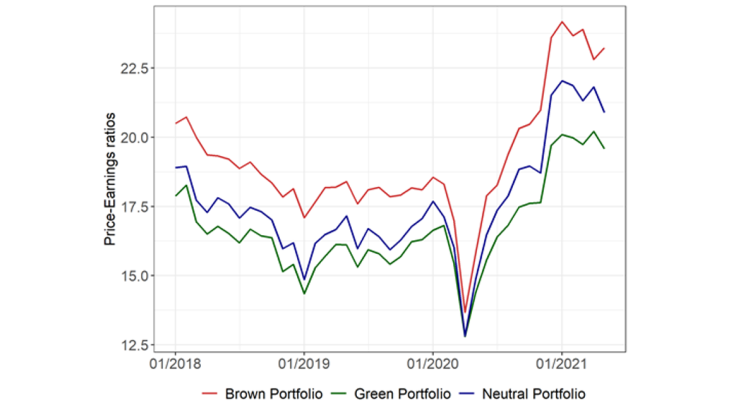The series show the prices of portfolios containing stocks in clean, neutral and polluting sectors respectively. Prices (equally weighted average for all firms in the portfolio) have been normalised to 100 in January 2018.
The “green bubble” narrative
Since the negative Covid-19 shock in March 2020, most equity indices have rebounded sharply, despite ongoing uncertainties over how the pandemic will evolve (gain of 28% in the S&P 500 between February 2020 and July 2021). A rise of this magnitude can be worrying if it signals that markets are disconnecting from their fundamentals, as this tends to increase the risk of a stock market correction (Chatelais and Stalla-Bourdillon, 2021).
Against this backdrop, certain sectors have risen more than others. To illustrate, Chart 1 shows the price trajectories for more than 2,500 global stocks, grouped according to whether they belong to a sector that is “clean” (clean fuel, renewable energies, etc.),
“polluting” and hence adversely affected by the ecological transition (oil, road transport, etc.), or “neutral”. While all three portfolios were negatively affected by the March 2020 shock, clean sectors have considerably outperformed polluting sectors in recent years. This has prompted some commentators to warn that a bubble might be forming in green assets (Aramonte and Zabai, 2021).
However, the phenomenon described above does not necessarily equate to a speculative bubble. First, equity prices need to be viewed against company fundamentals (using valuation metrics such as the price-to-earnings ratio or PER) in order to determine whether they are overstretched. Second, the “clean” portfolio shown in Chart 1 contains a limited number of firms, concentrated in just a few sectors. Any overvaluation of these assets is likely to be a localised phenomenon, and will only partially affect investors, as their positions tend to be more diversified.
Instead of focusing on the potential overvaluation of a small number of sectors, we take a broader approach based on the environmental score of companies (the "E" in ESG). In other words, our analysis focuses on the following question: for the economy as a whole, are companies with a better environmental score systematically overvalued? To this end, we construct a “green” portfolio containing a large panel of firms, selected on the basis of their environmental scores (Chart 2). Firms’ environmental scores incorporate measures such as their CO2 emissions, their environmental performance and their strategy towards renewable energies. The scores are normalised within each sector, leading to a "best-in-class" selection, preferred by most shareholders (i.e. investing in firms with the highest scores in their particular field of activity, and without excluding any sectors). Thus, our framework makes it possible to test whether there is a broad-based green bubble, which would be more damaging for investors.
Valuations are more conservative than expected
In theory, complying with environmental standards can have both a positive and negative impact on a firm’s valuation. If investors expect environmental risk to rise, this can push up the valuation of green assets, as investors will use them as a risk-hedging tool or to increase their exposure to the ecological transition (Pástor et al., 2020, Bolton et al., 2020). Demand for green assets can also be boosted by non-financial considerations (Fama and French, 2007). Finally, their prices may rise following their inclusion in popular indices, such as the MSCI Global Environment Index.
Conversely, a high environmental score may mean lower future profitability, especially if the firm’s management prioritises other goals over the maximisation of returns (Gillan et al., 2021). In addition, difficulties in assessing firms’ environmental performances and the risk of “greenwashing” result in a high rate of disagreement between environmental scores, which can in turn dilute green investment flows (Billio et al., 2020, Afota et al. 2021).
Chart 2 shows the median PER (using earnings for the last 12 months) for portfolios classified as “green”, “brown” and “neutral” based on thresholds set at the 30th and 70th percentiles of the environmental scores of the stocks used in Chart 1. As there is rarely a consensus over ESG scores, we construct a composite score using four sources: Asset4, CDP, RobecoSAM and Sustainalytics. We exclude from the analysis all firms for which disagreement over the environmental score was too high. However, the results are robust to the inclusion of all firms, and to the creation of portfolios based on the scores given separately by each source.


